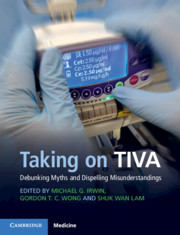Book contents
- Taking on TIVA
- Taking on TIVA
- Copyright page
- Contents
- Contributors
- Foreword
- Power to the People: the Rationale of a Practical Text
- Chapter 1 Why Bother?
- Chapter 2 You Say ‘PK’ and I Say ‘No Way!’; You Say ‘Keo’ and I Say ‘Time to Go!’
- Chapter 3 TCI and TIVA: What a Good Idea!
- Chapter 4 Milk of Amnesia
- Chapter 5 A Catwalk with a Difference
- Chapter 6 Let’s Get Started
- Chapter 7 Let’s Get Pumped!
- Chapter 8 ‘But I’m Used to MAC!’
- Chapter 9 Be Aware, Unaware and Confusion Everywhere
- Chapter 10 Do You Want Fries with That?
- Chapter 11 Intra- and Post-operative Analgesia for TIVA
- Chapter 12 Wakey Wakey!
- Chapter 13 Under Pressure
- Chapter 14 Ankle Biters
- Chapter 15 Old Timers
- Chapter 16 Big Can Be Beautiful!
- Chapter 17 A Bun in the Oven
- Chapter 18 Saving the Whales by Taking on TIVA
- Chapter 19 TIVA Drugs for Sedation
- Chapter 20 Skiing Off-Piste and Other Assorted Goodies
- Index
- References
Chapter 10 - Do You Want Fries with That?
The Role and Effects of Adjuvant Medications in TIVA
Published online by Cambridge University Press: 18 November 2019
- Taking on TIVA
- Taking on TIVA
- Copyright page
- Contents
- Contributors
- Foreword
- Power to the People: the Rationale of a Practical Text
- Chapter 1 Why Bother?
- Chapter 2 You Say ‘PK’ and I Say ‘No Way!’; You Say ‘Keo’ and I Say ‘Time to Go!’
- Chapter 3 TCI and TIVA: What a Good Idea!
- Chapter 4 Milk of Amnesia
- Chapter 5 A Catwalk with a Difference
- Chapter 6 Let’s Get Started
- Chapter 7 Let’s Get Pumped!
- Chapter 8 ‘But I’m Used to MAC!’
- Chapter 9 Be Aware, Unaware and Confusion Everywhere
- Chapter 10 Do You Want Fries with That?
- Chapter 11 Intra- and Post-operative Analgesia for TIVA
- Chapter 12 Wakey Wakey!
- Chapter 13 Under Pressure
- Chapter 14 Ankle Biters
- Chapter 15 Old Timers
- Chapter 16 Big Can Be Beautiful!
- Chapter 17 A Bun in the Oven
- Chapter 18 Saving the Whales by Taking on TIVA
- Chapter 19 TIVA Drugs for Sedation
- Chapter 20 Skiing Off-Piste and Other Assorted Goodies
- Index
- References
Summary
Propofol is a potent anaesthetic agent and may be used as a sole agent for sedation. Although it reduces post-operative pain, probably via its anti-oxidant and anti-inflammatory properties, it is not an analgesic. Consequently, to produce anaesthesia with no response to noxious stimuli a very large dose is required.[1–3] Therefore it is important to use an analgesic agent (usually an opioid) to produce surgical anaesthesia and decrease propofol requirements.[3] In some ways, this differs from inhalational anaesthetic drugs, which tend to have analgesic as well as hypnotic properties. Apart from opioids, which are the most potent analgesic agents, there are many other drugs that can be added to propofol and opioid-based anaesthesia. Among these are dexmedetomidine, magnesium, ketamine and lidocaine. The advantages and logic of mixing these agents with TIVA are discussed in this chapter.
- Type
- Chapter
- Information
- Taking on TIVADebunking Myths and Dispelling Misunderstandings, pp. 73 - 79Publisher: Cambridge University PressPrint publication year: 2019



